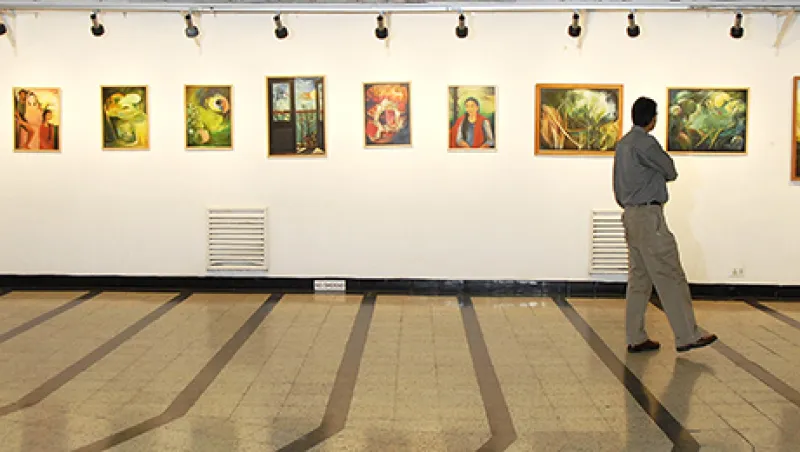“Making money is art,” Andy Warhol once wrote. A growing number of people who collect paintings, sculptures and other pieces would take a different view of the relation between art and money: Art is about making money.
In the Art & Finance Report 2014,published by Deloitte Luxembourg and London-based market research firm ArtTactic, 76 percent of surveyed collectors said they were “buying art for collecting purposes, but with an investment view,” versus 53 percent in 2012.
That approach makes economic sense over the longer term when art is viewed as an alternative-asset class. The Mei Moses All Art index, which tracks repeat sales across multiple art categories, posted a 7 percent compound annual return between 2003 and 2013, slightly below the Standard & Poor’s 500 index’s annual total return of 7.4 percent for the same period. Some individual categories had higher compound annual returns, including postwar and contemporary art (10.5 percent) and Chinese art (14.9 percent). Art ownership, of course, also offers aesthetic rewards in addition to financial returns.
Still, few collectors can afford to buy multimillion-dollar pieces and maintain a diversified investment portfolio. Art funds can make sense for nonbillionaire investors because they offer pooled buying power, diversification and professional management. The Fine Art Fund Group in London, established in 2001, is one of the older and larger funds, with more than $350 million in assets under contract. Newer and smaller vehicles include the $18 million, Malta-domiciled Fine Art Invest Fund and the $20 million Tiroche DeLeon Collection, registered in Gibraltar.
These funds are usually structured as limited partnerships or limited liability companies with fixed life spans of five to ten years. Accredited investors — those meeting the Securities and Exchange Commission’s Regulation D requirements for income or net worth — buy in as limited partners or nonmanaging LLC members. The general partners or managers typically operate the fund for a 1 or 2 percent annual charge against assets under management and a 20 percent share of returns over an agreed-upon hurdle performance rate, according to Evan Beard, New York–based U.S. art and finance coordinator for Deloitte U.S.
Most funds currently use a “hybrid private equity model,” Beard explains. A former auction house head or expert teams up with a financial partner who has hedge fund or private equity experience. The art expert sources, acquires and sells the art; the financial manager handles the fund’s legal and financial details.
“All the funds that are coming out now are private equity structures, [with] opportunistic people with a really, really strong background in the art world who can buy and sell and source works fairly quickly,” Beard says. “It’s not a buy-and-hold strategy like it was years ago.”
Wealth management firms are largely overlooking these offerings, though. Just “8 percent of wealth managers are currently offering clients advice on investing in art investment funds, down from 26 percent in 2012,” the Art & Finance Report 2014 said. Beard points to a few reasons for the decline. Several art funds have closed, and new funds tend to be closely held syndicates that don’t welcome outsiders’ investments.
Also, U.S. regulations including Section 913 of the Dodd-Frank Wall Street Reform and Consumer Protection Act and the Department of Labor’s proposed conflict-of-interest rules have caused many private banks and wealth management firms to preemptively move toward a fiduciary standard, which creates a higher due diligence bar for investments. As a result, several firms have removed from their investment platforms or severely restricted exotic vehicles like art funds because of the inherent due diligence hurdles, Beard says. This also explains why many art funds have become syndicates targeting investors not subject to ERISA rules.
Jeremy Eckstein, an independent art investment fund consultant based in London, views funds’ fee structures as a potential stumbling block. “By the time you take the management costs and the dealing costs and the incentivization of the managers into account, it’s proven to be very difficult to strike the right sort of balance ... over the planned lifetime of the fund,” Eckstein says. “It very often doesn’t really give a fund the opportunity of making a profit.”
Another reason for advisers’ hesitance is the unique due diligence skillset that art fund investments require. Investors must evaluate the fund’s financial structure and its investment potential. Wealth managers can readily grasp the finance projections, but few are equipped to gauge the fund manager’s art market expertise, proposed acquisition market or strategy for buying and selling profitably, Beard notes.
Investments in art and other collectibles have additional risks beyond those associated with financial assets. In a recent article, Stephen Brodie, a New York–based partner with law firm Herrick, Feinstein whose expertise includes art law, discussed the potential impact on a fund of forgeries and title disputes, which can occur when thieves or authorities procure an artwork from its rightful owner. The unreimbursed loss of a single art investment for either reason “may have a materially detrimental effect on the fund’s performance and the investors’ returns,” Brodie writes. Although title insurance is now available in the U.S. and Europe, he points out that the topic receives little discussion in funds’ private placement memorandums.
Despite wealth managers’ lack of enthusiasm, the Deloitte/ArtTactic report’s authors remain upbeat, conjecturing that art funds could become “one-stop service platforms for the wealth-management industry, offering vetted and tested expertise, transparent and professional reporting, and operation within a regulatory framework.” Time will tell if that portrait turns out to be accurate.






